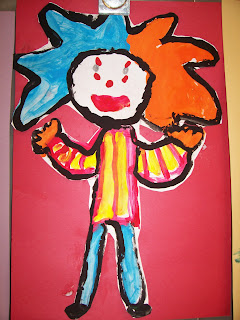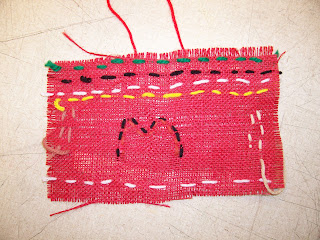This was a great end of the year lesson with my kindergarteners. I got the lesson from a recent School Arts magazine. The focus of the lesson was on camouflage, what it is and how animals use it to protect or hide themselves. We spent a day discussing this while each table had some pictures to look at and later describe to the class. After wards they each got to choose whether they wanted a tiger or a leopard and they received a quarter sheet of animal print paper. After gluing this down to a sheet of construction paper, they finished the camouflage pattern with appropriate colored crayons.




I made tracers of 'big cat' body shapes which the children used the following class period to trace and cut out their cats. The next period they glued down their cats and began adding the 'habitat', which they made by ripping paper into grass and tree shapes.




The last class was spent putting on finishing touches such as more grass, eyes and teeth or extra stripes or spots on their animals.
I liked this lesson a lot because the students were able to see the great results possible by breaking a project down into smaller pieces. They learned about camouflage, the behaviours of 2 different animals as well as carefully observing the actual patterns on these two animals.
This lesson would also be appropriate for 1st grade.
 I promised 1st graders that they could free paint the last day of class (they unanimously agreed this was what they wanted to do!) The more I thought about this, however, the more I didn't want them to have at the supplies with abandon as this often leads to lots of paper in the trash... Instead I had them write their first initial on a large sheet of paper as a bubble letter using oil pastels. They added minimal designs inside their letters with a reminder that white oil pastels could be used also, as it would show up when they paint over it. Then they were allowed to paint their letters however they liked. This worked so much better and their was no waste at the end. Most kids love anything having to do with their names, so this was a perfect one day lesson!
I promised 1st graders that they could free paint the last day of class (they unanimously agreed this was what they wanted to do!) The more I thought about this, however, the more I didn't want them to have at the supplies with abandon as this often leads to lots of paper in the trash... Instead I had them write their first initial on a large sheet of paper as a bubble letter using oil pastels. They added minimal designs inside their letters with a reminder that white oil pastels could be used also, as it would show up when they paint over it. Then they were allowed to paint their letters however they liked. This worked so much better and their was no waste at the end. Most kids love anything having to do with their names, so this was a perfect one day lesson!




















































